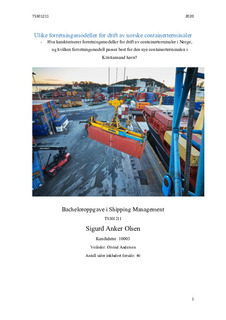| dc.description.abstract | Sentrale politiske føringer har som mål at en større andel av godstrafikken i Norge skal flyttes fra land til sjø. De fleste norske havner er kommunalt eid, men private terminaloperatørselskap kan delvis eller helt stå for driften av containerterminalen. For en effektiv og bærekraftig drift av containertermaler er det viktig å se på forretningsmodeller for denne driften, og kanskje spesielt når det skal gjøres endringer, slik som ved Kristiansand havn hvor containerterminalen skal flyttes. Så hensikten med denne oppgaven er derfor:
Hva karakteriserer forretningsmodeller for drift av containerterminaler i Norge, og hvilken forretningsmodell passer best for den nye containerterminalen i Kristiansand havn
For å svare den første problemstilling ble det brukt kvantitativ metode og det ble sendt spørreskjema til norske havner med containerterminaler. For å belyse den andre problemstillingen ble kvalitativ metode brukt og tre sentrale aktører i Kristiansand havn ble intervjuet.
Fjorten av 26 havner med containerterminaler svarte på spørreskjema. Åtte av havnene har en driftsmodell hvor havna står for noe av driften selv og outsourcer noe, mens bare 1 havn gjør alt selv. Det ble ikke funnet noe sammenheng mellom størrelsen på containerterminalen og driftsmodell. Norske havner er villing til å la private aktører få en større rolle i driften av containerterminalen. Dermed vil havnene ligne mer på Landlord ports enn Tool ports eller Public ports.
For at den nye containerterminalen i Kristiansand havn skal bli driftet på en bærekraftig måte, bør Kristiansand havn ha en forretningsmodell som er en blanding av Tool port- og Landlord port-modellen hvor det blant annet settes bærekraftige og miljøvennlige krav til de terminaloperatørselskaper som vil være med å konkurrer gjennom et anbud, hvor det er en vinner, om å drive med lastehåndtering på containerterminalen. Dette vil ivareta havnas behov for å sette krav, samtidig som det ivaretar konkurranseaspektet.
Konklusjon
De fleste norske havner er fornøyd med dagens driftsmodell for containerhavna, men de har likevel vurdert andre forretningsmodeller, og da la private aktører få en større plass. For en effektiv og bærekraftig drift på den nye containerterminalen bør, Kristiansand havn ha en forretningsmodell som er en blanding av en Tool port og en Landlord port, og som inkluderer konkurranse mellom terminaloperatørene. Konkurranse bør skje i en tidlig fase, for eksempel når havna skal ut etter anbud. Her bør havna også fremme miljø- og bærekraftkrav, slik at terminaloperatørselskapet som vinner og havna har samme forståelse for at dette er viktig | |
| dc.description.abstract | Central political guidelines aim to move a larger share of freight traffic in Norway from land to sea. Most Norwegian ports are municipally owned, but private terminal operator companies can partly or completely be responsible for the operation of the container terminal. For efficient and sustainable container terminal operations, it is important to look at business models of operation. This is especially true when changes are to be made, such as at Port of Kristiansand where the container terminal is to be relocated. Therefore, the questions this essay address are:
What characterizes business models for container terminal operations in Norway, and which business model is best suited for the new container terminal in port of Kristiansand?
To answer the first question, a quantitative method was used and a questionnaire was sent to Norwegian ports with container terminals. To shed light on the second issue, a qualitative method was used, and three key players in the Port of Kristiansand were interviewed.
Fourteen of 26 ports with container terminals responded to the questionnaire. Eight of the ports have an operating model where the ports themselves are responsible for some of the operations while others are outsourced, and only 1 port do everything itself. No correlation was found between the size of the container terminal and the chosen operating model. Norwegian ports are willing to allow private companies to play a greater role in their container terminal operations. Thus, the ports will look more like Landlord ports than Tool ports or Public ports.
For the new container terminal in the port of Kristiansand to be operated in a sustainable manner, Port of Kristiansand should have a business model that is a mixture of a Tool port and a Landlord port, and which includes competition between the terminal operators. Competition should take place at an early stage, for example when the port is going out to tender, rather than later. Here, the port should also promote environmental and sustainability requirements, so that the terminal operator company that wins and the port have the same understanding that this is important. This will take care of the ports' need to set requirements, at the same time as it takes care of the competition aspect.
Conclusion
Most Norwegian ports are satisfied with the current operating model for their container ports, but they have nevertheless considered other business models, which will allow private companies a larger space. For an efficient and sustainable operation of the new container terminal, the Port of Kristiansand should choose a business model which is a combination of a Tool port and a Landlord port, and which will accommodate competition between terminal operators. Competition should be carried out at an early stage, for example when the port is going out to tender. Here, the port should also promote the environment and sustainability as requirements, so that the terminal operator company that wins and the port have the same understanding that this is important. | |
